Wearable K Band Sensors for Telemonitoring and Telehealth and Telemedicine Systems
Abstract
1. Introduction
1.1. Introduction to Wearable Antennas for Telemonitoring and Telemedicine Systems
- Wearable sensors and antennas are applied to monitor personal Telemedicine devices to assist elderly, asthmatic, diabetic, and epileptic patients.
- Wearable sensors and antennas may be applied to monitor healthcare activities such as patient health monitoring, patient treatment and care, and personal health monitoring.
- Wearable sensors and antennas may be applied to operate IoT, Telemedicine, and Telehealth devices.
1.2. New K Band Wearable Slot Antennas
2. Wideband K Band T-Shape Slot Antennas for Telemonitoring and Telemedicine Systems
3. Wideband Fractal K Band T-Shape Slot Antennas for Telemonitoring and Telemedicine Systems
4. Wideband Vertical Fractal K Band Slot Antennas Array for Telemedicine Systems
5. Wideband K Band Horizontal Polarized Slot Antennas Array for Telemedicine Systems
6. Applications of Wideband K Band Sensors for Telemonitoring and Telemedicine Systems
7. Conclusions
Funding
Institutional Review Board Statement
Informed Consent Statement
Data Availability Statement
Conflicts of Interest
References
- Fang, D.G. Antenna Theory and Microstrip Antennas; CRC Press: Boca Raton, FL, USA, 2019; ISBN 9780367384678. [Google Scholar]
- Fujimoto, K.; Morishita, H. Modern Small Antennas; Cambridge University Press (CUP): Cambridge, UK, 2014; ISBN 978-0-521-87786-2. [Google Scholar]
- Constantine, A. Balanis, Antenna Theory Analysis and Design, 4th ed.; Wiley Sons: Hoboken, NJ, USA, 2016. [Google Scholar]
- Sabban, A. New Wideband printed Antennas for Medical Applications. IEEE J. Trans. Antennas Propag. 2013, 61, 84–91. [Google Scholar] [CrossRef]
- Sabban, A. Microstrip Antenna Arrays. In Microstrip Antennas; Nasimuddin, N., Ed.; InTech: London, UK, 2011; pp. 361–384. ISBN 978-953-307-247-0. Available online: http://www.intechopen.com/articles/show/title/microstrip-antenna-arrays (accessed on 1 November 2011).
- Sabban, A. Novel Wearable Antennas for Communication and Medical Systems; Taylor & Francis Group: Boca Raton, FL, USA, 2017. [Google Scholar]
- Sabban, A. Wideband RF Technologies and Antennas in Microwave Frequencies; Wiley: Hoboken, NJ, USA, 2016. [Google Scholar]
- Sabban, A. Low Visibility Antennas for Communication Systems; Taylor & Francis Group: Boca Raton, FL, USA, 2015. [Google Scholar]
- Rajab, K.; Mittra, R.; Lanagan, M. Size Reduction of Microstrip Antennas using Metamaterials. In Proceedings of the 2005 IEEE Antennas and Propagation Society International Symposium, Washington, DC, USA, 3–8 July 2005; pp. 296–299. [Google Scholar]
- Pendry, J.B.; Holden, A.J.; Stewart, W.J.; Youngs, I. Extremely Low Frequency Plasmons in Metallic Mesostructures. Phys. Rev. Lett. 1996, 76, 4773–4776. [Google Scholar] [CrossRef] [PubMed]
- El-Hameed, A.S.A.; Ouf, E.G.; Elboushi, A.; Seliem, A.G.; Izumi, Y. An Improved Performance Radar Sensor for K-Band Automotive Radars. Sensors 2023, 23, 7070. [Google Scholar] [CrossRef] [PubMed]
- Chatterjee, A.; Saha, S.; Sarkar, S.; Sarkar, P.P. Metamaterial and Frequency Selective Surface Assisted Antenna Design; IOP: Bristol, UK, 2025; ISBN 978-0-7503-5420-2. [Google Scholar]
- Singh, A.K.; Abegaonkar, M.P.; Koul, S.K. Metamaterials for Antenna Applications; Taylor & Francis Group: Boca Raton, FL, USA, 2024; ISBN 9780367493547. [Google Scholar]
- Nakano, H. Low-Profile Natural and Metamaterial Antennas: Analysis Methods and Applications; Wiley: Hoboken, NJ, USA, 2016; ISBN 9781118859797. [Google Scholar]
- Marqués, R.; Martel, J.; Mesa, F.; Medina, F. Left-Handed-Media Simulation and Transmission of EM Waves in Subwavelength Split-Ring-Resonator-Loaded Metallic Waveguides. Phys. Rev. Lett. 2002, 89, 183901. [Google Scholar] [CrossRef]
- Zhu, J.; Eleftheriades, G.V. A Compact Transmission-Line Metamaterial Antenna with Extended Bandwidth. IEEE Antennas Wirel. Propag. Lett. 2008, 8, 295–298. [Google Scholar] [CrossRef]
- Baena, J.D.; Marque′s, R.; Martel, J.; Medina, F. Experimental results on metamaterial simulation using SRR-loaded Waveguides. In Proceedings of the IEEE-AP/S International Symposium on Antennas and Propagation, Columbus, OH, USA, 22–27 June 2003; pp. 106–109. [Google Scholar]
- Marqués, R.; Martel, J.; Mesa, F.; Medina, F. A new 2D isotropic left-handed metamaterial design: Theory and experiment. Microw. Opt. Technol. Lett. 2002, 35, 405–408. [Google Scholar] [CrossRef]
- Sabban, A. New Compact Wearable Metamaterials Circular Patch Antennas for IoT, Medical and 5G Applications. Appl. Syst. Innov. 2020, 3, 42. [Google Scholar] [CrossRef]
- Sabban, A. Small Wearable Metamaterials Antennas for Medical Systems. Appl. Comput. Electromagn. Soc. J 2016, 31, 434–443. [Google Scholar]
- Sabban, A. Wearable Antenna Measurements in Vicinity of Human Body. Wirel. Eng. Technol. 2016, 7, 97–104. [Google Scholar] [CrossRef]
- Sabban, A. Active Compact Wearable Body Area Networks for Wireless Communication, Medical and IoT Applications. Appl. Syst. Innov. 2018, 1, 46. [Google Scholar] [CrossRef]
- Chirwa, L.; Hammond, P.; Roy, S.; Cumming, D. Electromagnetic radiation from ingested sources in the human intestine between 150 MHz and 1.2 GHz. IEEE Trans. Biomed. Eng. 2003, 50, 484–492. [Google Scholar] [CrossRef] [PubMed]
- Werber, D.; Schwentner, A.; Biebl, E.M. Investigation of RF transmission properties of human tissues. Adv. Radio Sci. 2006, 4, 357–360. [Google Scholar] [CrossRef]
- Gupta, B.; Sankaralingam, S.; Dhar, S. Development of wearable and implantable antennas in the last decade: A review. In Proceedings of the 10th Mediterranean Microwave Symposium (MMS), Guzelyurt, Northern Cyprus, 25–27 August 201; pp. 251–267.
- Thalmann, T.; Popovic, Z.; Notaros, B.M.; Mosig, J.R. Investigation and design of a multi-band wearable antenna. In Proceedings of the 3rd European Conference on Antennas and Propagation, EuCAP 2009, Berlin, Germany, 23–27 March 2009; pp. 462–465. [Google Scholar]
- Salonen, P.; Rahmat-Samii, Y.; Kivikoski, M. Wearable antennas in the vicinity of human body. In Proceedings of the IEEE Antennas and Propagation Society Symposium, Monterey, CA, USA, 20–25 June 2004; Volume 1, pp. 467–470. [Google Scholar]
- Kellomaki, T.; Heikkinen, J.; Kivikoski, M. Wearable antennas for FM reception. In Proceedings of the 2006 1st European Conference on Antennas and Propagation (EuCAP), Nice, France, 6–10 November 2006; pp. 1–6. [Google Scholar]
- Sabban, A. Microstrip Antenna and Antenna Arrays. U.S. Patent US 4,623,893, 18 November 1986. [Google Scholar]
- Jamil, F.; Ahmad, S.; Iqbal, N.; Kim, D.-H. Towards a Remote Monitoring of Patient Vital Signs Based on IoT-Based Blockchain Integrity Management Platforms in Smart Hospitals. Sensors 2020, 20, 2195. [Google Scholar] [CrossRef]
- Jamil, F.; Iqbal, M.A.; Amin, R.; Kim, D. Adaptive Thermal-Aware Routing Protocol for Wireless Body Area Network. Electronics 2019, 8, 47. [Google Scholar] [CrossRef]
- Shahbazi, Z.; Byun, Y.-C. Towards a Secure Thermal-Energy Aware Routing Protocol in Wireless Body Area Network Based on Blockchain Technology. Sensors 2020, 20, 3604. [Google Scholar] [CrossRef]
- Lin, J.; Itoh, T. Active integrated antennas. IEEE Trans. Microw. Theory Tech. 1994, 42, 2186–2194. [Google Scholar] [CrossRef]
- Mortazwi, A.; Itoh, T.; Harvey, J. Active Antennas and Quasi-Optical Arrays; John Wiley & Sons: New York, NY, USA, 1998. [Google Scholar]
- Jacobsen, S.; Klemetsen, O. Improved Detectability in Medical Microwave Radio-Thermometers as Obtained by Active Antennas. IEEE Trans. Biomed. Eng. 2008, 55, 2778–2785. [Google Scholar] [CrossRef]
- Jacobsen, S.; Klemetsen, Ø. Active antennas in medical microwave radiometry. Electron. Lett. 2007, 43, 606–608. [Google Scholar] [CrossRef]
- Ellingson, S.W.; Simonetti, J.H.; Patterson, C.D. Design and Evaluation of an Active Antenna for a 29–47 MHz Radio Telescope Array. IEEE Trans. Antennas Propag. 2007, 55, 826–831. [Google Scholar] [CrossRef]
- Segovia-Vargas, D.; Castro-Galan, D.; Garcia-Munoz, L.E.; Gonzalez-Posadas, V. Broadband Active Receiving Patch With Resistive Equalization. IEEE Trans. Microw. Theory Tech. 2008, 56, 56–64. [Google Scholar] [CrossRef]
- Rizzoli, V.; Costanzo, A.; Spadoni, P. Computer-Aided Design of Ultra-Wideband Active Antennas by Means of a New Figure of Merit. IEEE Microw. Wirel. Compon. Lett. 2008, 18, 290–292. [Google Scholar] [CrossRef]
- Waher, P. Learning Internet of Things; Packt Publishing: Birmingham, UK, 2015; ISBN 13:97-81783553532. [Google Scholar]
- Sabban, A. Innovation and Review in, Health Monitoring Systems and Wearable Medical Sensors. Ann. Clin. Med. Case Rep. J. 2023, 11, 1–15. [Google Scholar]
- Ahmed, M.I.; Ahmed, M.F. Antennas for Wearable Applications; Intech: London, UK, 2018. [Google Scholar] [CrossRef]
- Falkoner, F.J. The Geometry of Fractal Sets; Cambridge University Press: Cambridge, UK, 1990. [Google Scholar]
- Rusu, M.V.; Baican, R. Chapter 16, Fractal Antenna Application. In Microwave and Millimeter Wave Technologies from Photonic Bandgap Devices to Antenna and Applications; Minin, I., Ed.; Intech: London, UK, 2010; pp. 351–382. ISBN 978-953-7619-66-4. [Google Scholar]
- Rusu, M.; Hirvonen, M.; Rahimi, H.; Enoksson, P.; Rusu, C.; Pesonen, N.; Vermesan, O.; Rustad, H. Minkowski Fractal Microstrip Antenna for RFID Tags. In Proceedings of the 38th European Microwave Conference (EuMC), Amsterdam, The Netherlands, 28–30 October 2008; pp. 666–669. [Google Scholar]
- Rahimi, H.; Rusu, M.; Enoksson, P.; Sandstrom, D.; Rusu, C. Small Patch Antenna Based on Fractal Design forWireless Sensors. In Proceedings of the MME07, 18thWorkshop on Micromachining, Micromechanics, and Microsystems, Guimaraes, Portugal, 16–18 September 2007. [Google Scholar]
- Mandelbrot, B. How Long Is the Coast of Britain? Statistical Self-Similarity and Fractional Dimension. Science 1967, 156, 636–638. [Google Scholar] [CrossRef] [PubMed]
- Fujimoto, K. Antenna for Small Mobile Terminals; Artech House: Norwood, MA, USA, 2018. [Google Scholar]
- Sankaralingam, S.; Dhar, S.; Gupta, B.; Osman, L.; Zeouga, K.; Gharsallah, A. Performance of Electro-Textile Wearable Circular Patch Antennas in the Vicinity of Human Body at 2.45 GHz. Procedia Eng. 2013, 64, 179–184. [Google Scholar] [CrossRef][Green Version]
- Cao, Z.; Lu, M. Advancements in Wearable Antenna Design: A Comprehensive Review of Materials, Fabrication Techniques, and Future Trends in Wireless Communication. Micromachines 2025, 16, 1028. [Google Scholar] [CrossRef]
- Georgiadis, A.; Rogier, H.; Roselli, L.; Arcioni, P. Microwave and Millimeter Wave Circuits and Systems: Emerging Design, Technologies, and Applications; Wiley: Hoboken, NJ, USA, 2012. [Google Scholar]
- Declercq, F.; Rogier, H. Active Integrated Wearable Textile Antenna With Optimized Noise Characteristics. IEEE Trans. Antennas Propag. 2010, 58, 3050–3054. [Google Scholar] [CrossRef]
- Sabban, A. Wearable Circular Polarized Antennas for Health Care, 5G, Energy Harvesting, and IoT Systems. Electronics 2022, 11, 427. [Google Scholar] [CrossRef]
- Cheng, S.-A.; Tan, S.I.; Goh, S.L.E.; Ko, S.Q. The Value of Remote Vital Signs Monitoring in Detecting Clinical Deterioration in Patients in Hospital at Home Programs or Postacute Medical Patients in the Community: Systematic Review. J. Med Internet Res. 2025, 27, e64753. [Google Scholar] [CrossRef]
- Goudarzi, A.; Ghayoor, F.; Waseem, M.; Fahad, S.; Traore, I. A Survey on IoT-Enabled Smart Grids: Emerging, Applications, Challenges, and Outlook. Energies 2022, 15, 6984. [Google Scholar] [CrossRef]
- Waseem, M.; Khan, M.A.; Goudarzi, A.; Fahad, S.; Sajjad, I.A.; Siano, P. Incorporation of Blockchain Technology for Different Smart Grid Applications: Architecture, Prospects, and Challenges. Energies 2023, 16, 820. [Google Scholar] [CrossRef]
- Chandravanshi, S.; Katare, K.K.; Akhtar, M.J. A Flexible Dual-Band Rectenna With Full Azimuth Coverage. IEEE Access 2021, 9, 27476–27484. [Google Scholar] [CrossRef]
- Shah, I.A.; Zada, M.; Shah, S.A.A.; Basir, A.; Yoo, H. Flexible Metasurface-Coupled Efficient Wireless Power Transfer System for Implantable Devices. IEEE Trans. Microw. Theory Tech. 2023, 72, 2534–2547. [Google Scholar] [CrossRef]
- Sabban, A. Novel Meta-Fractal Wearable Sensors and Antennas for Medical, Communication, 5G, and IoT Applications. Fractal Fract. 2024, 8, 100. [Google Scholar] [CrossRef]
- Keysight. ADS Momentum Software. Available online: http://www.keysight.com/en/pc-1297113/advanced-design-systemads?cc=IL&lc=eng (accessed on 3 January 2018).
- Gabriel, C.; Gabriel, S.; Corthout, E. The dielectric properties of biological tissues: I. Literature survey. Phys. Med. Biol. 1996, 41, 2231–2249. [Google Scholar] [CrossRef]
- Sabban, A. Green Wearable Sensors and Antennas for Bio-Medicine, Green Internet of Things, Energy Harvesting, and Communication Systems. Sensors 2024, 24, 5459. [Google Scholar] [CrossRef]
- Ali, W.; Uddin, N.; Zahid, M.; Shoaib, S. Performance Analysis and Design Optimization of Wearable RFID Sensor-Antenna System for Healthcare Applications. IEEE Access 2025, 13, 145540–145555. [Google Scholar] [CrossRef]

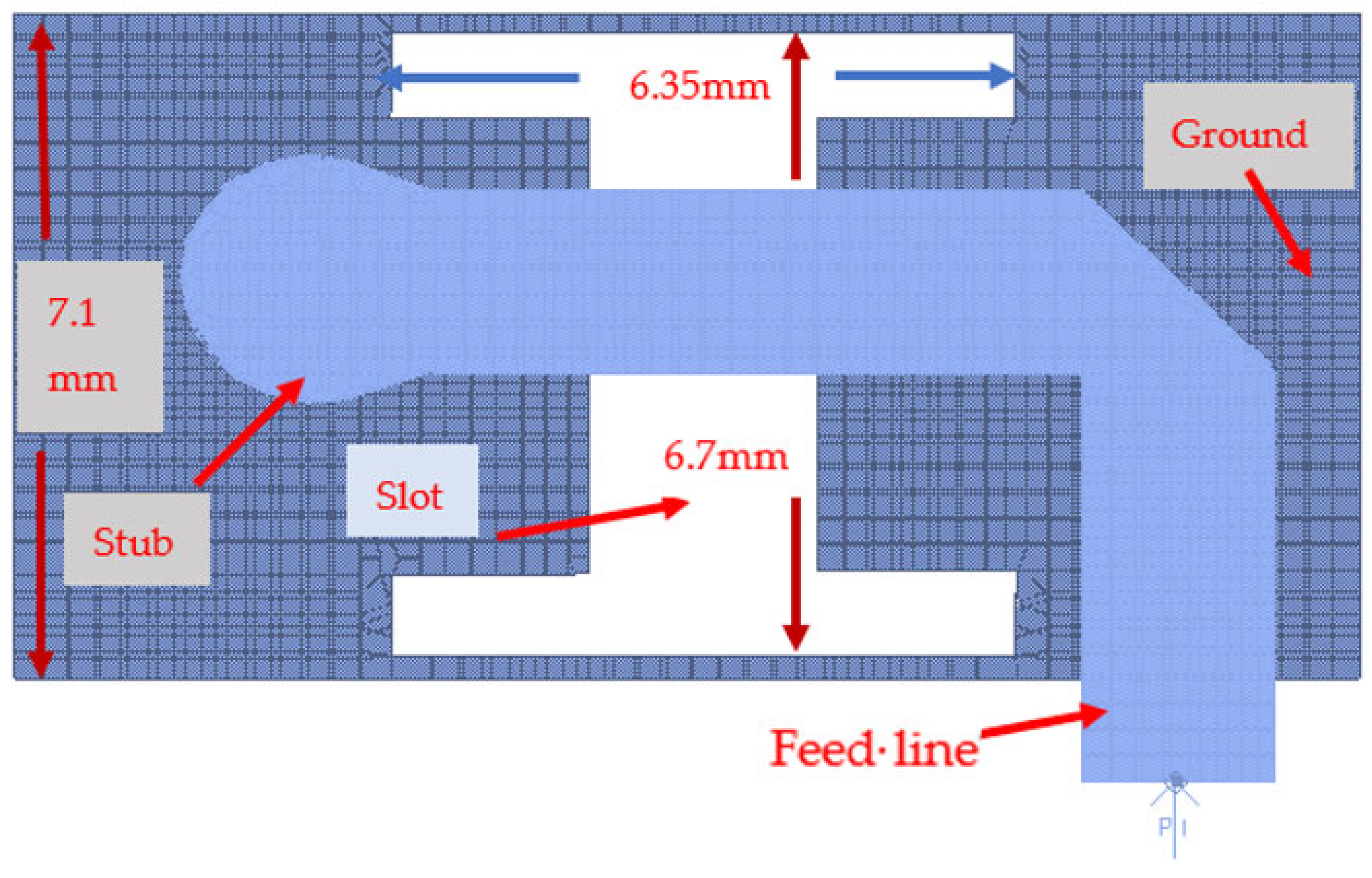
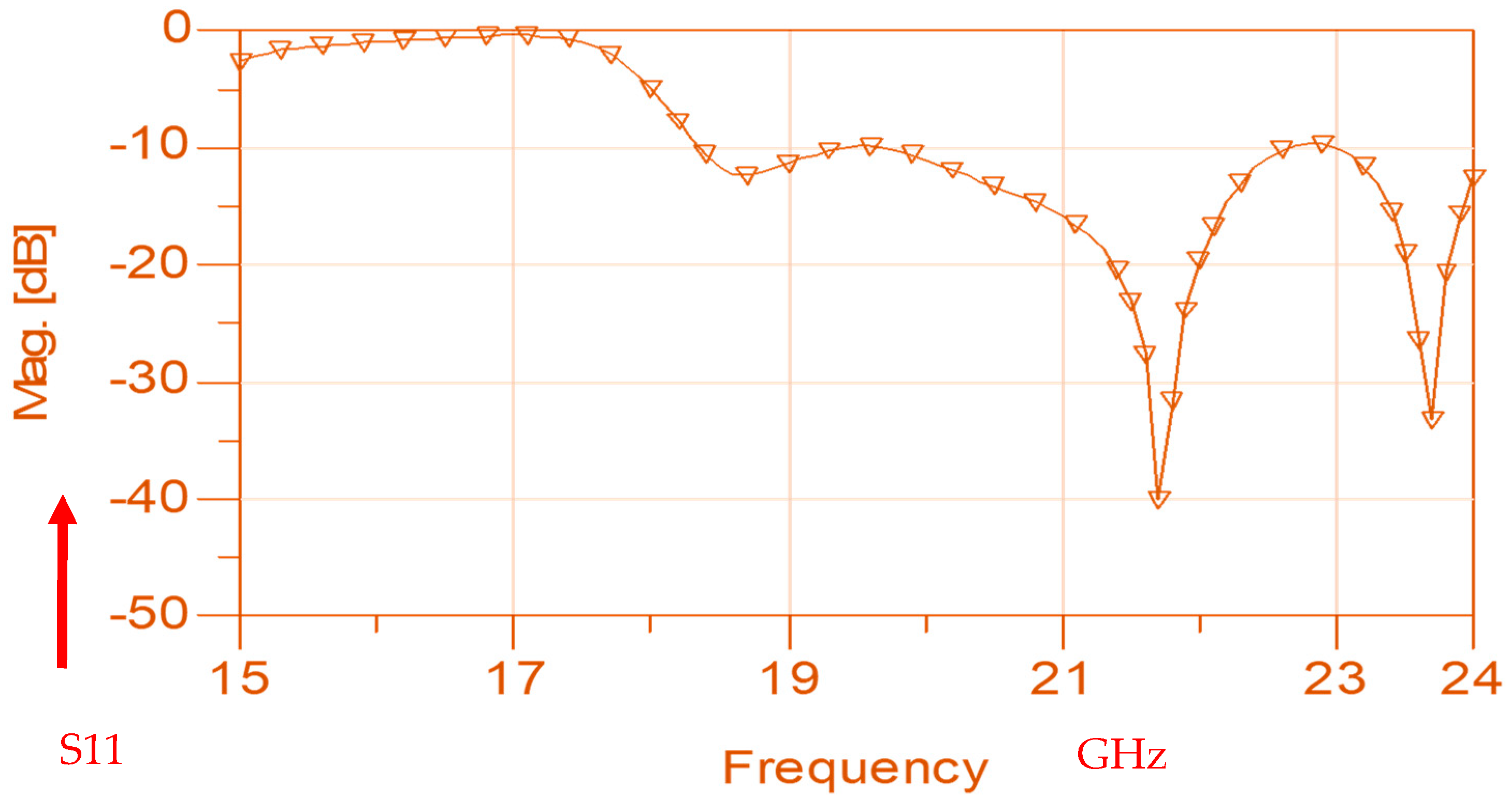

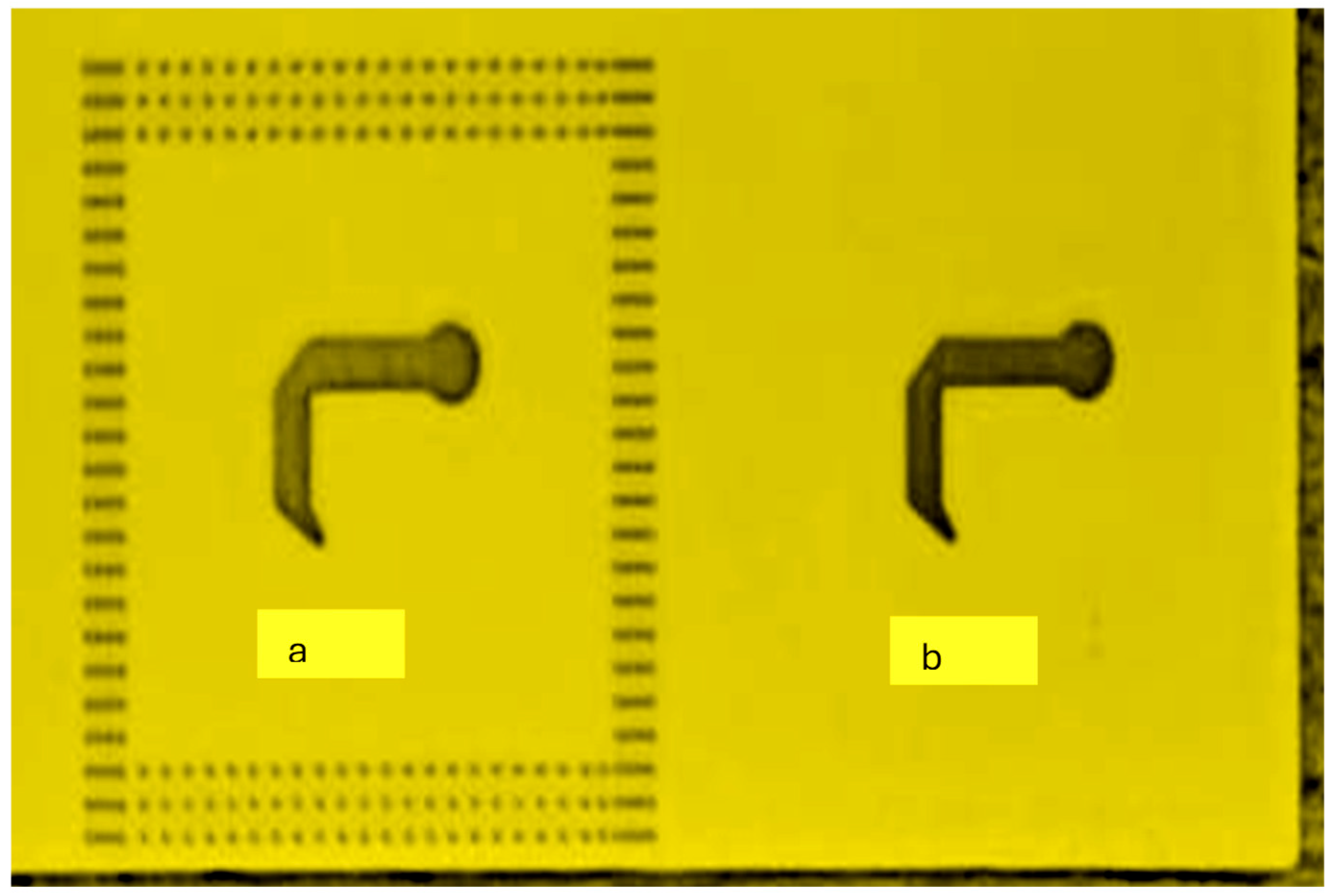



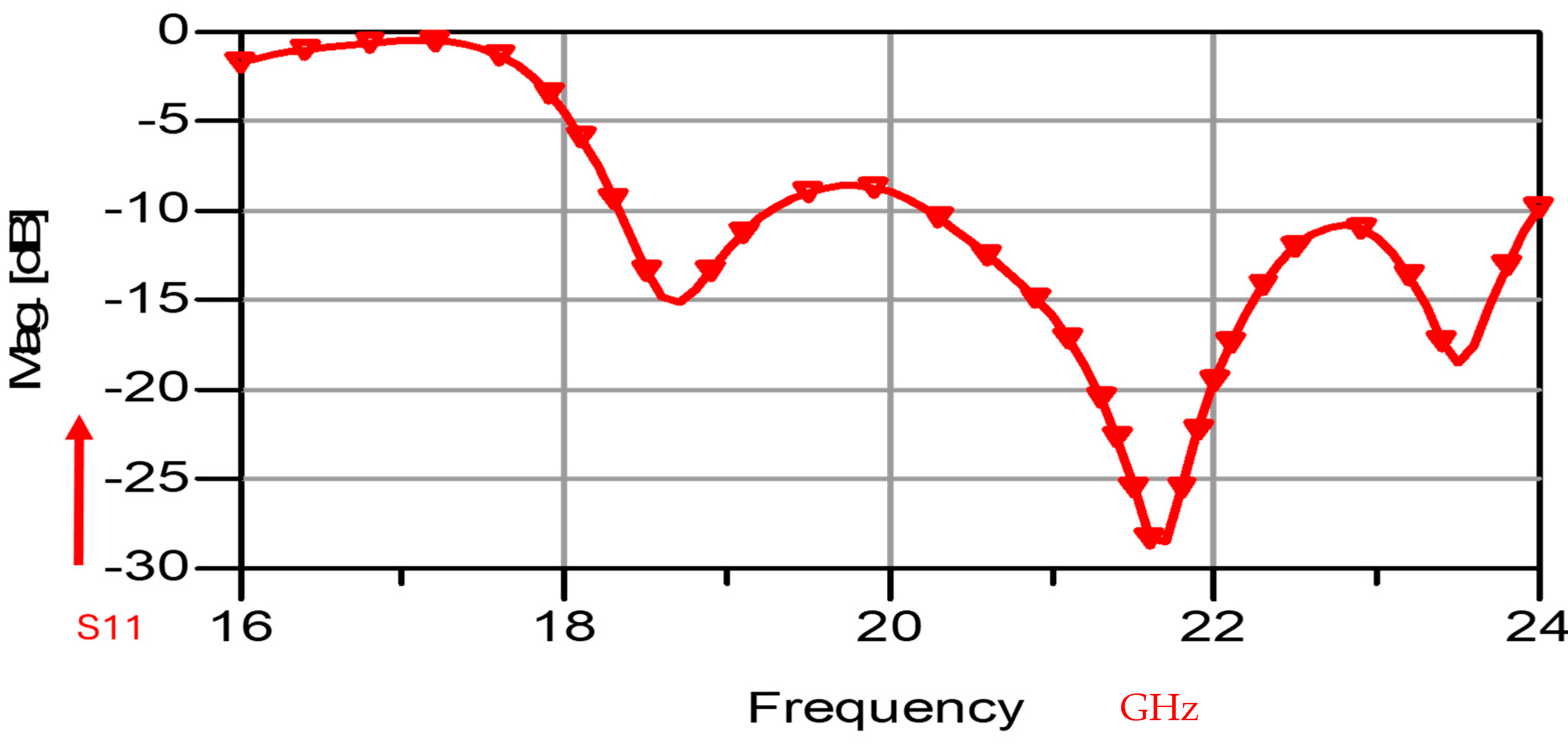
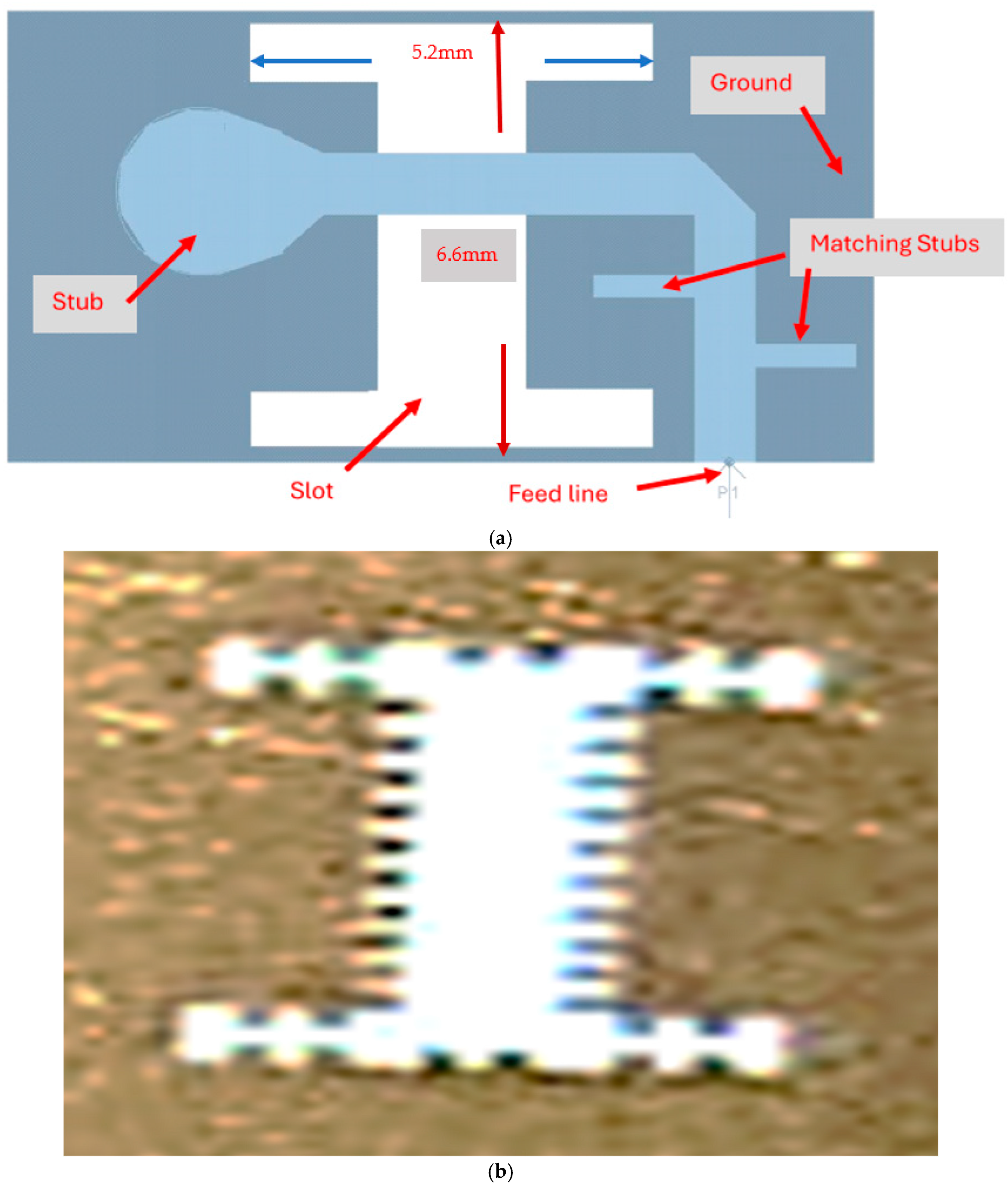


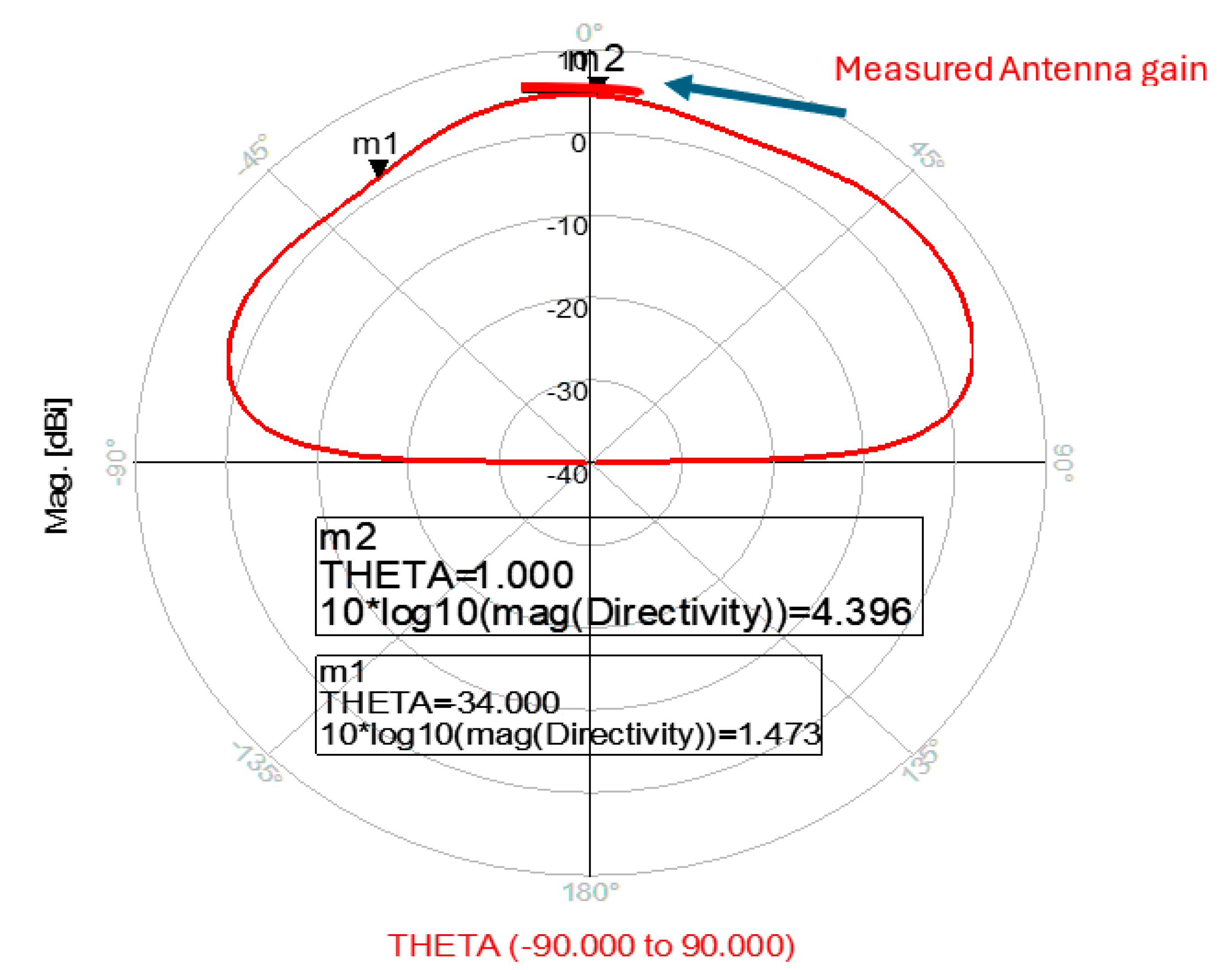

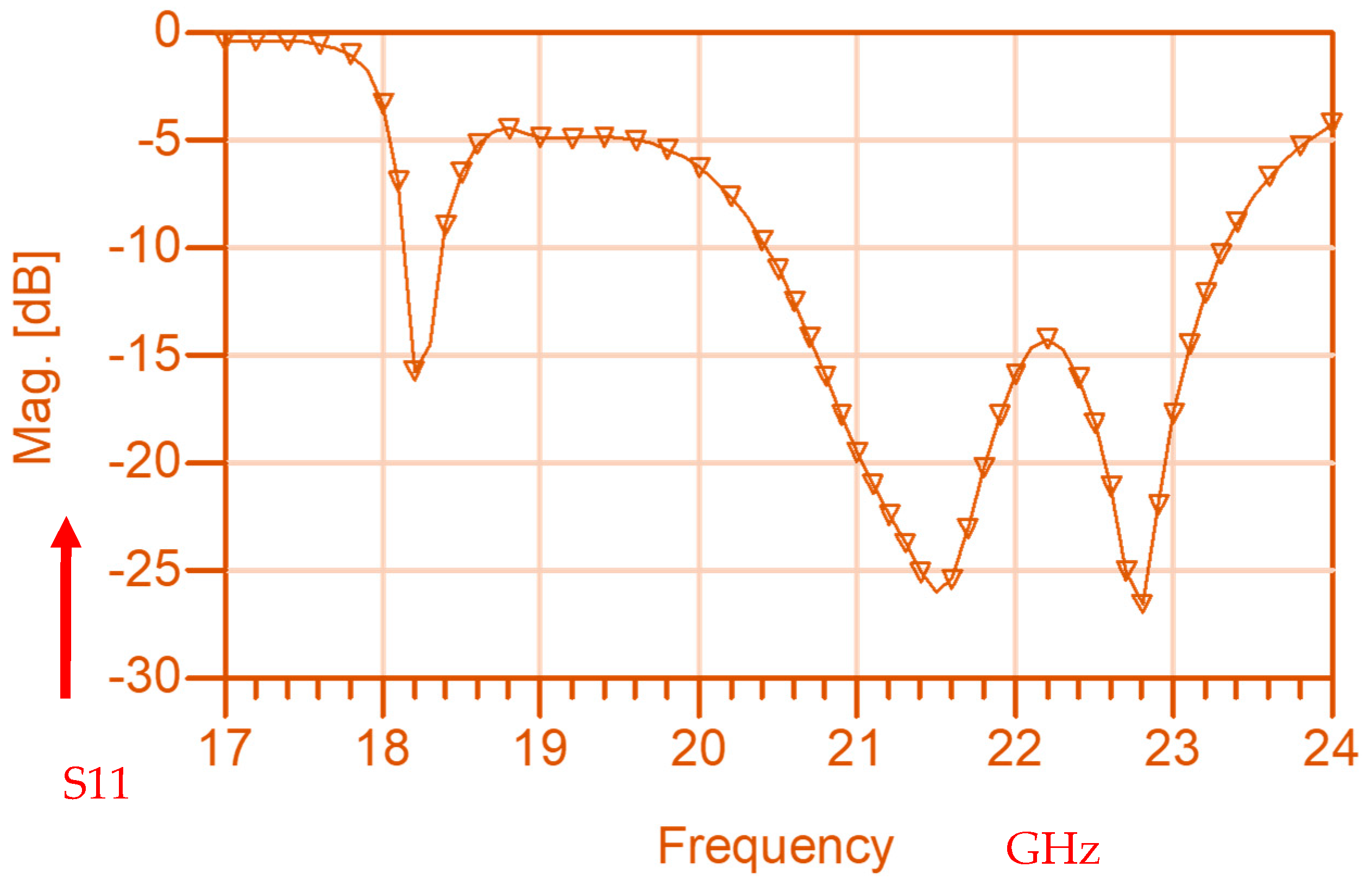
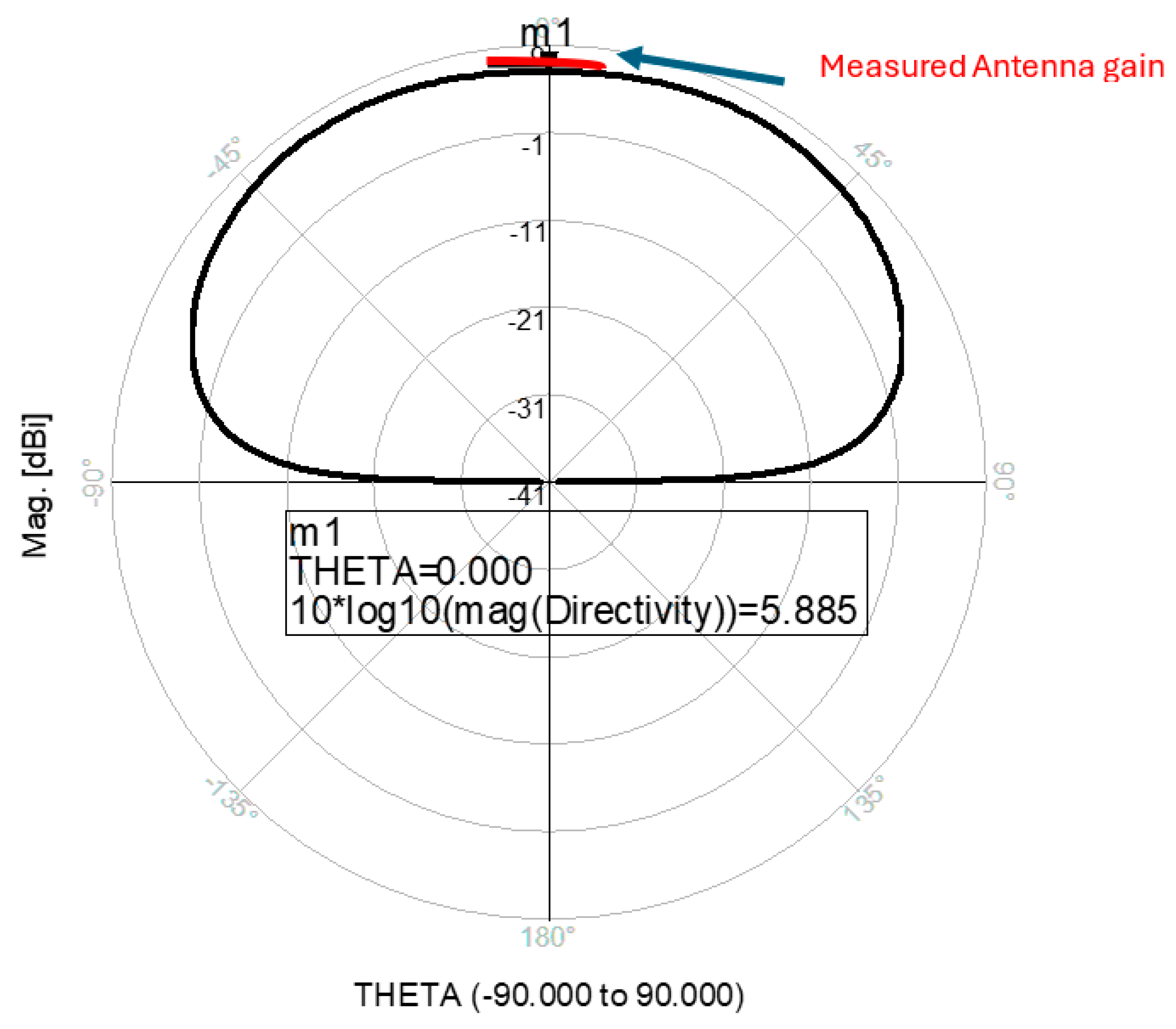
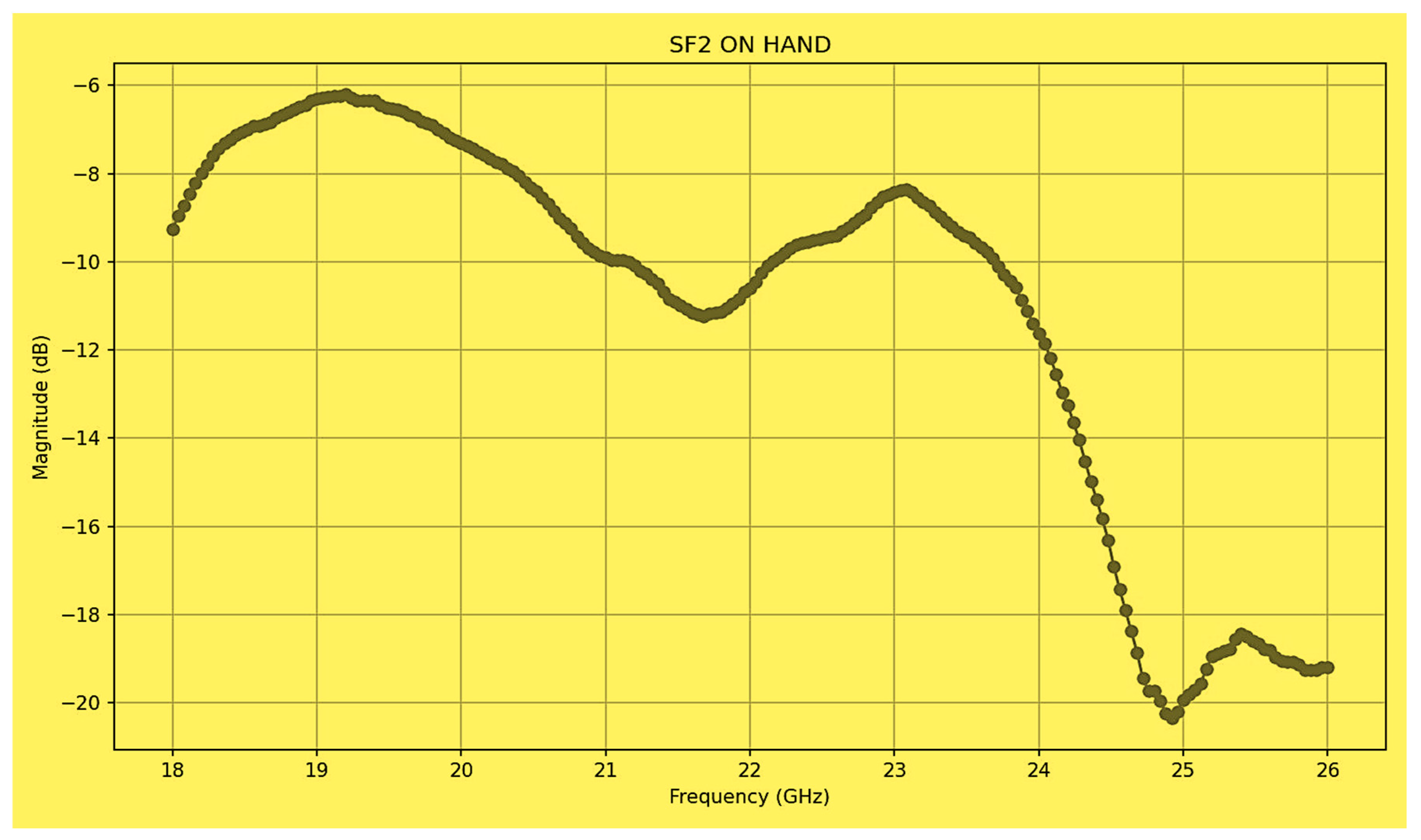

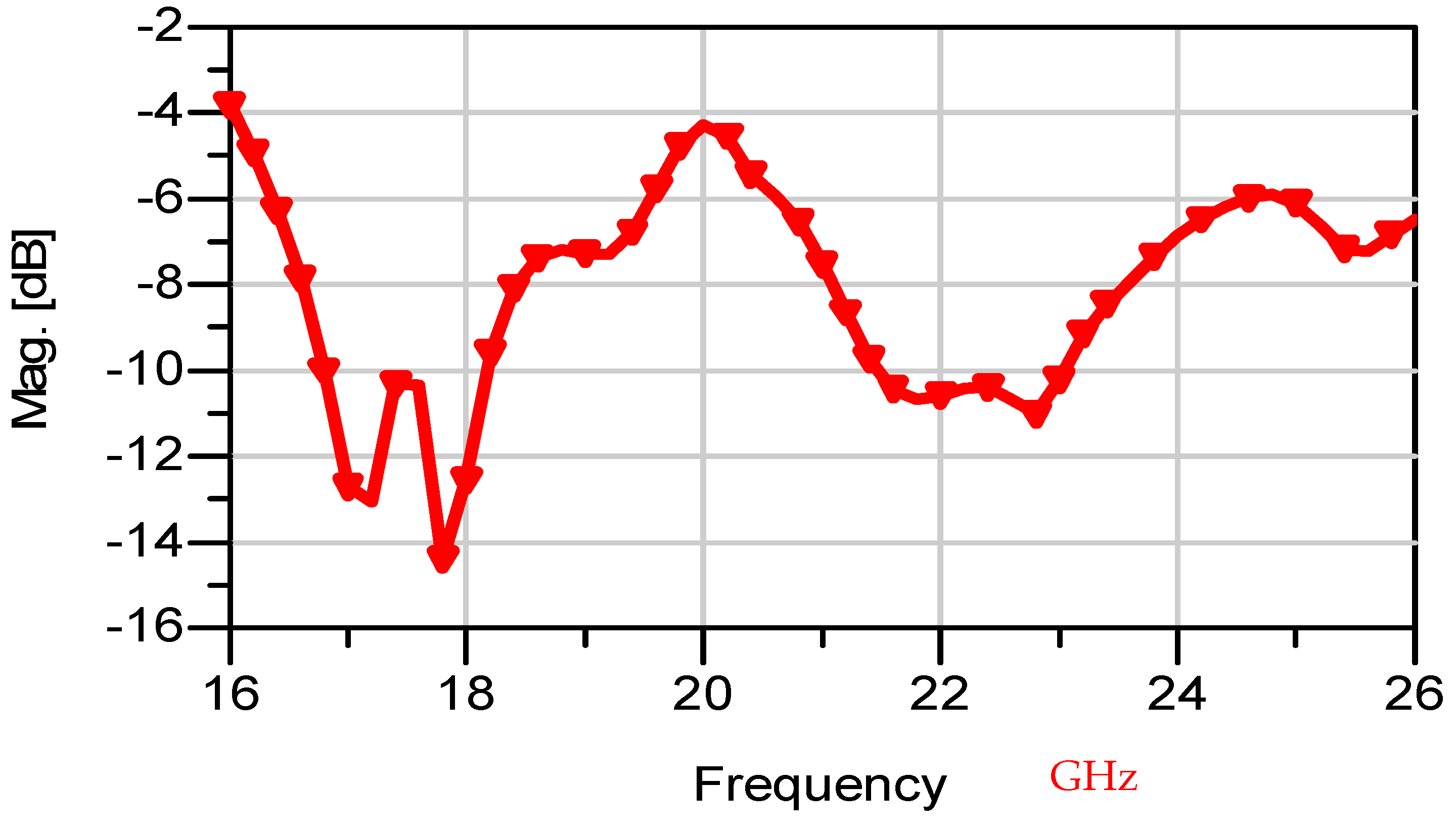
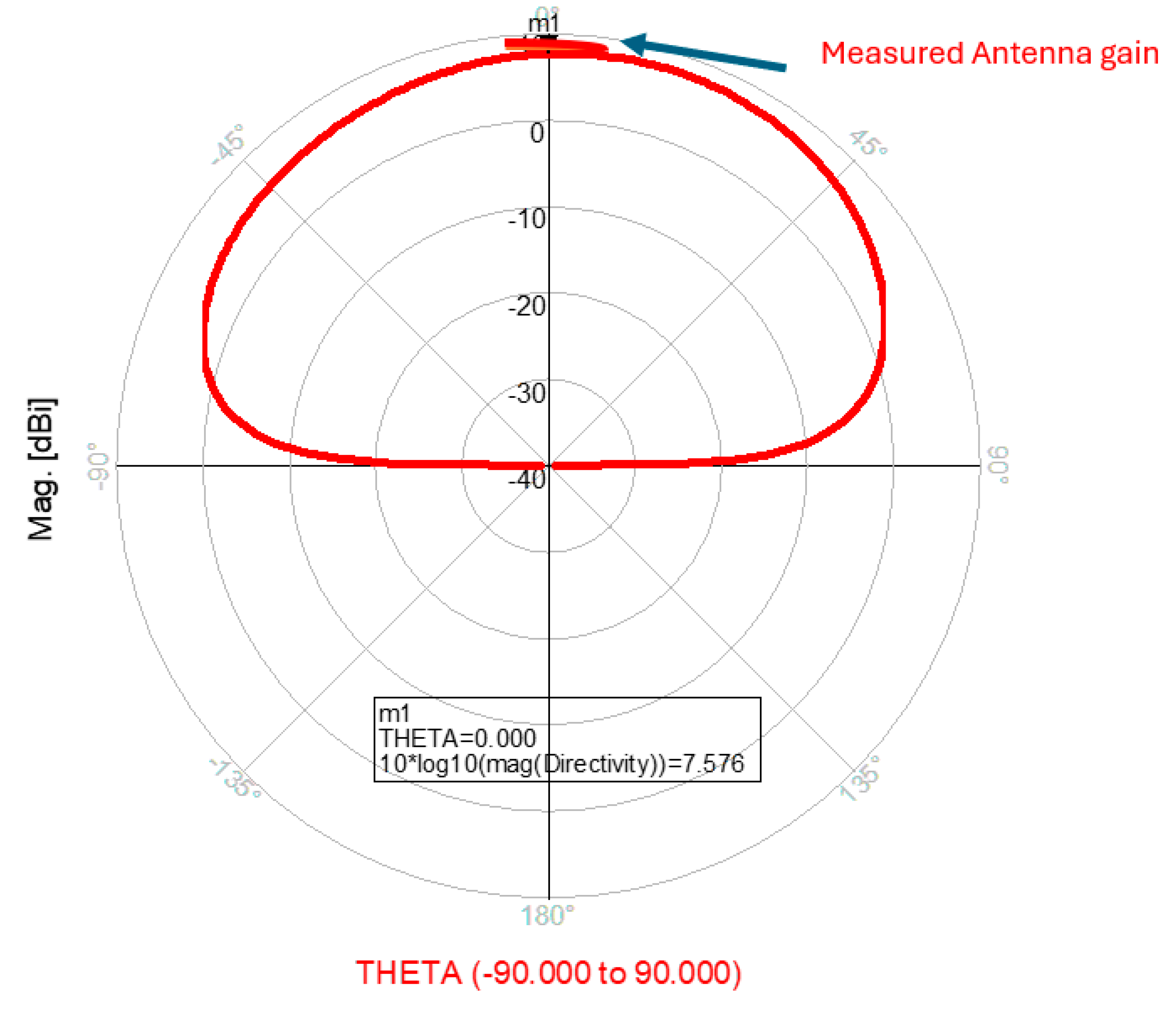
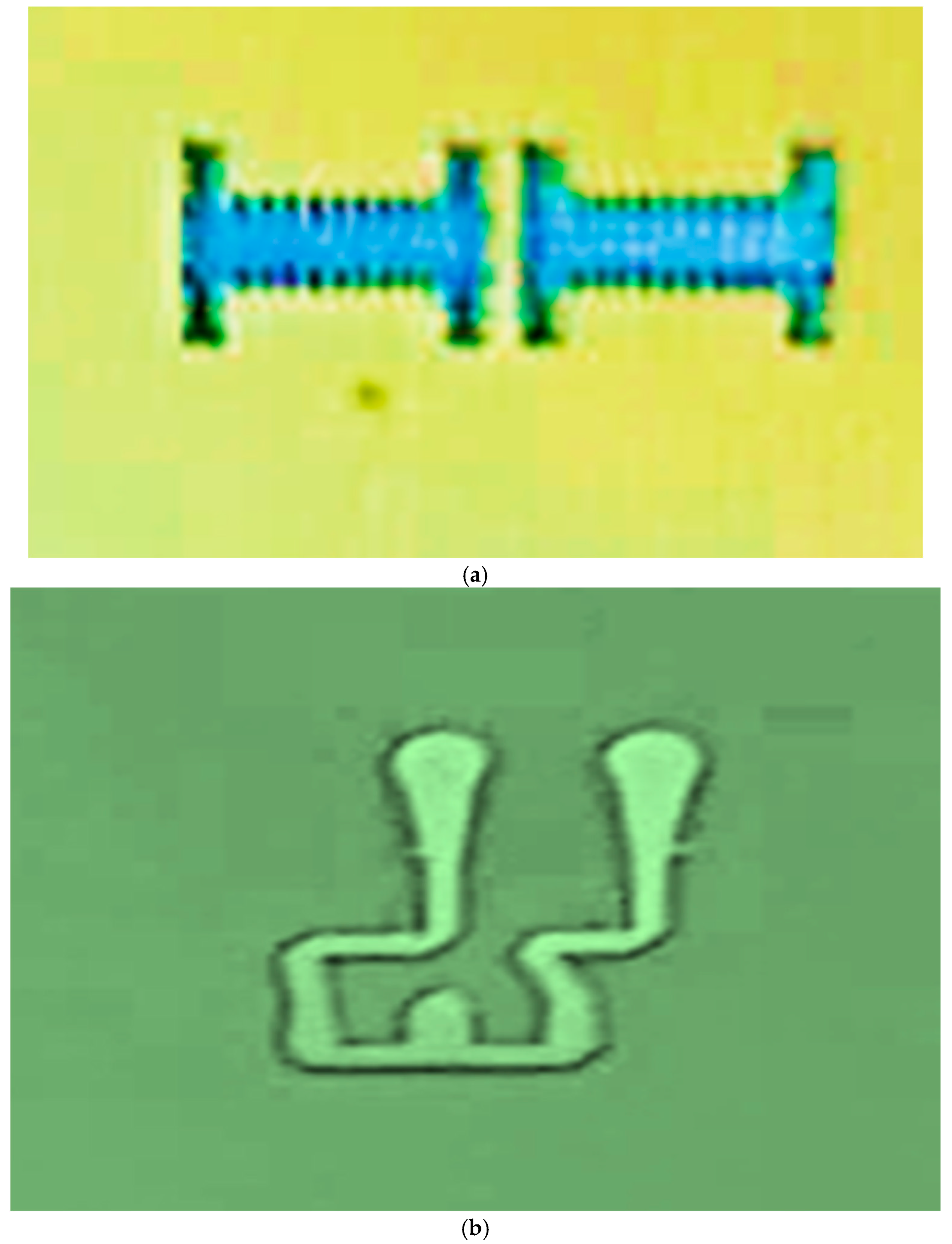

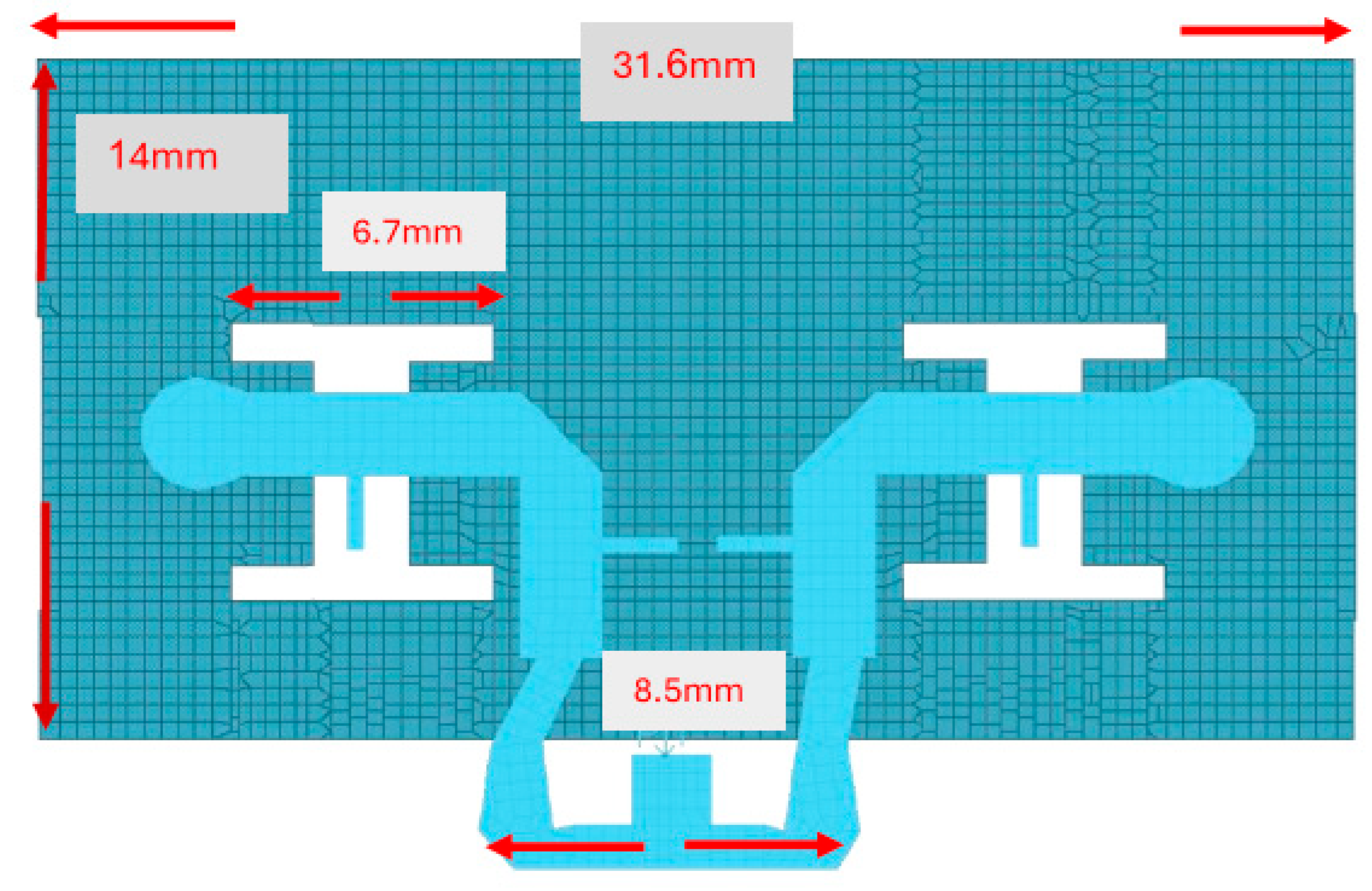
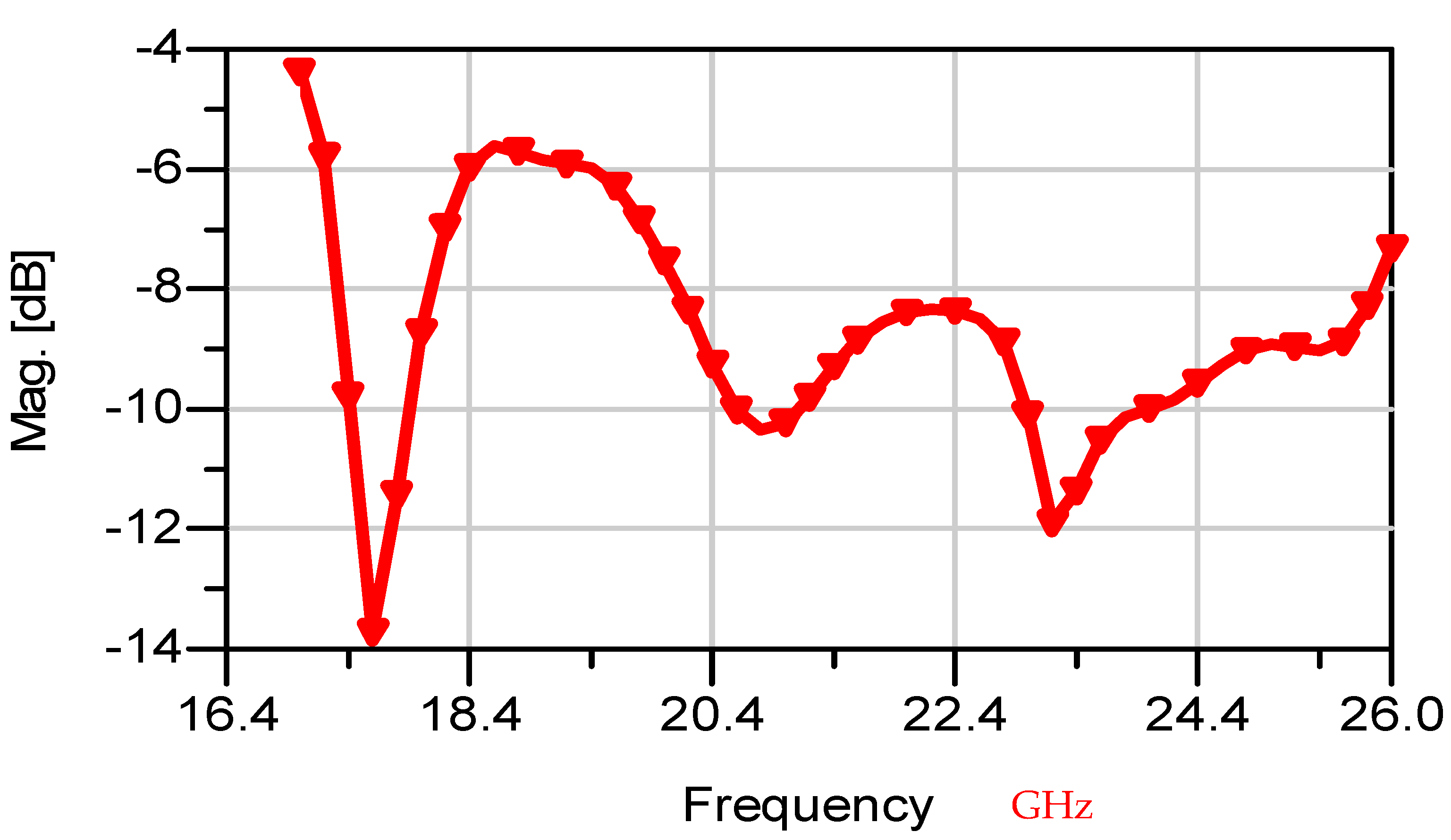
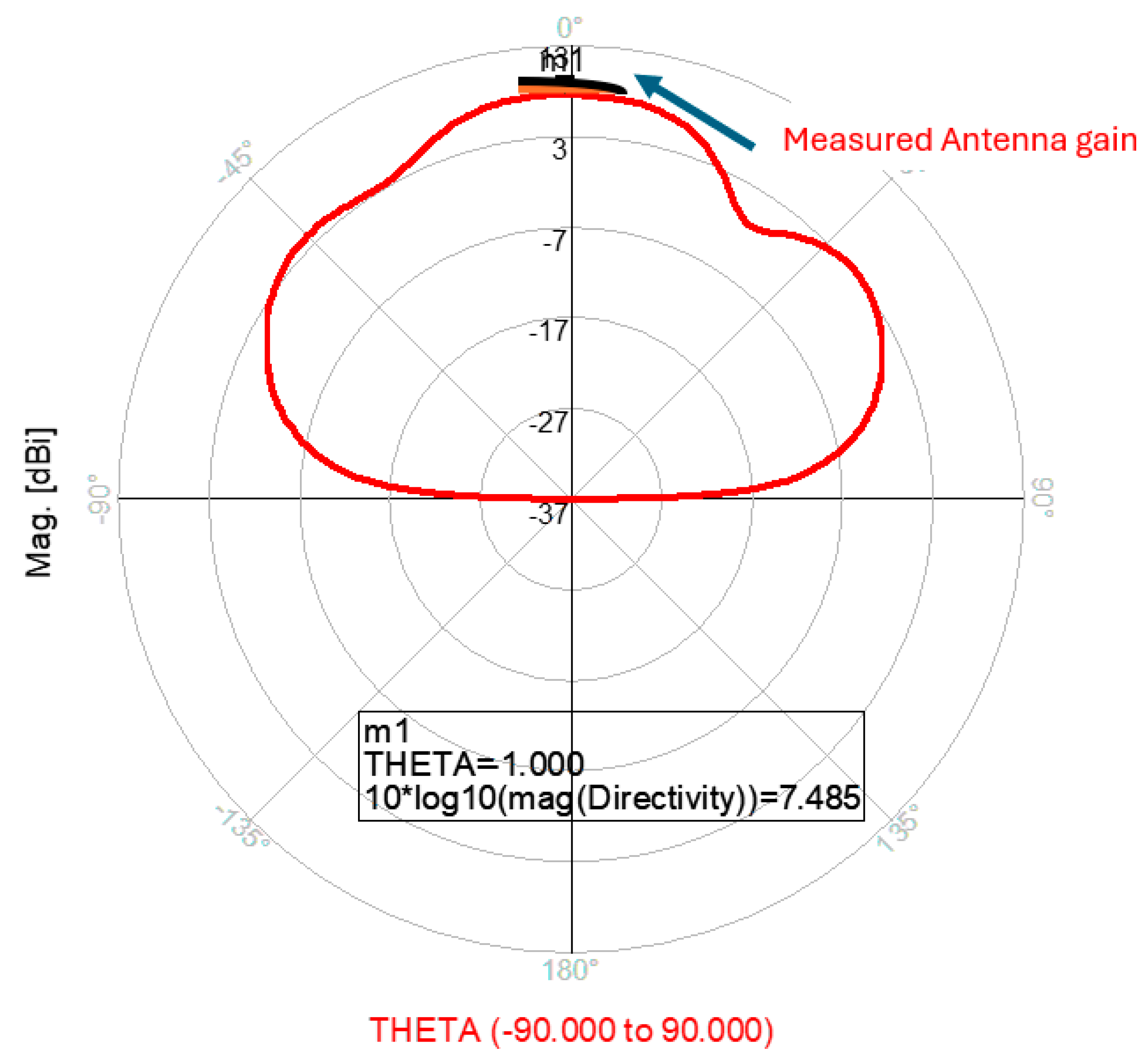

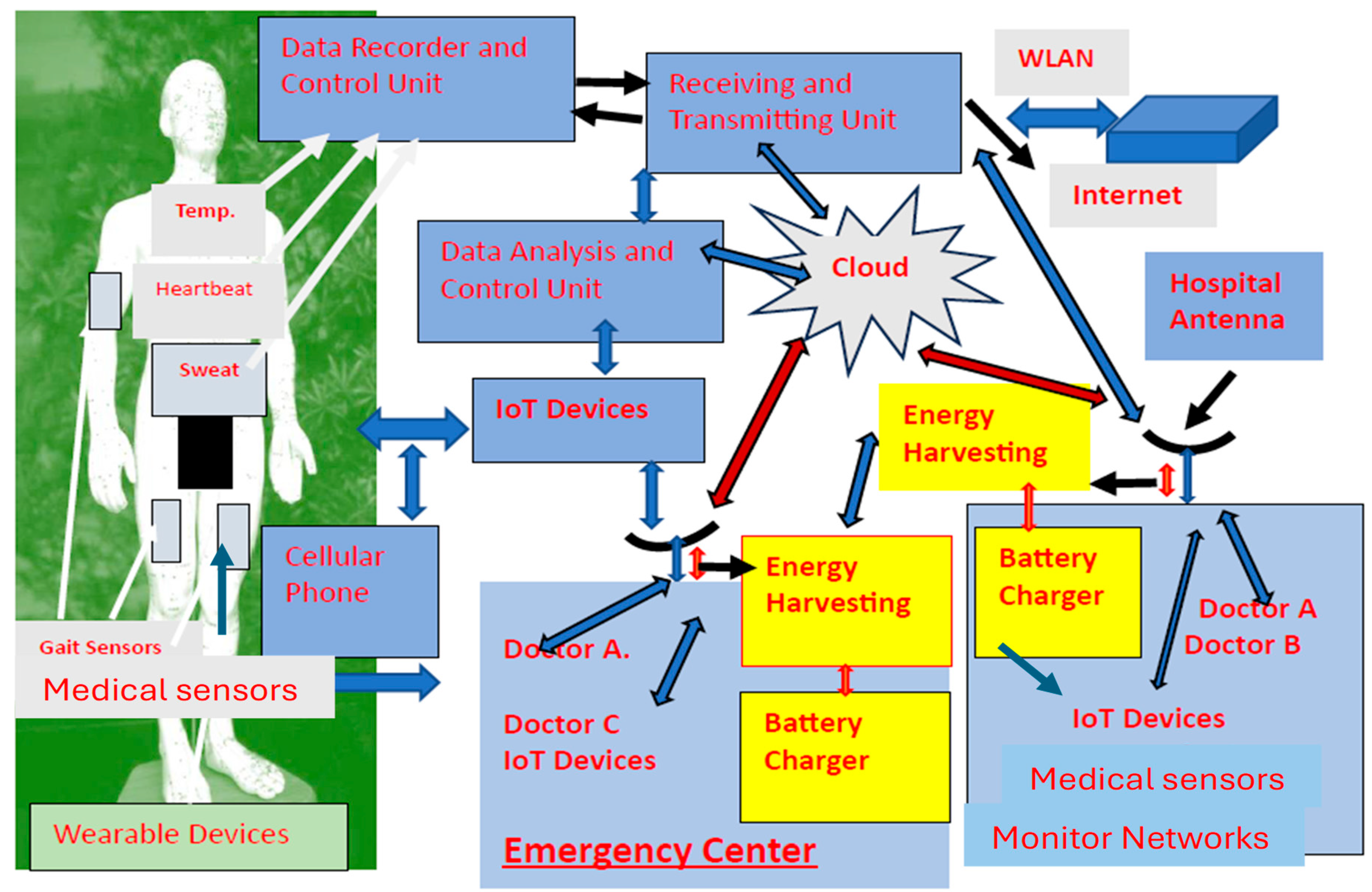
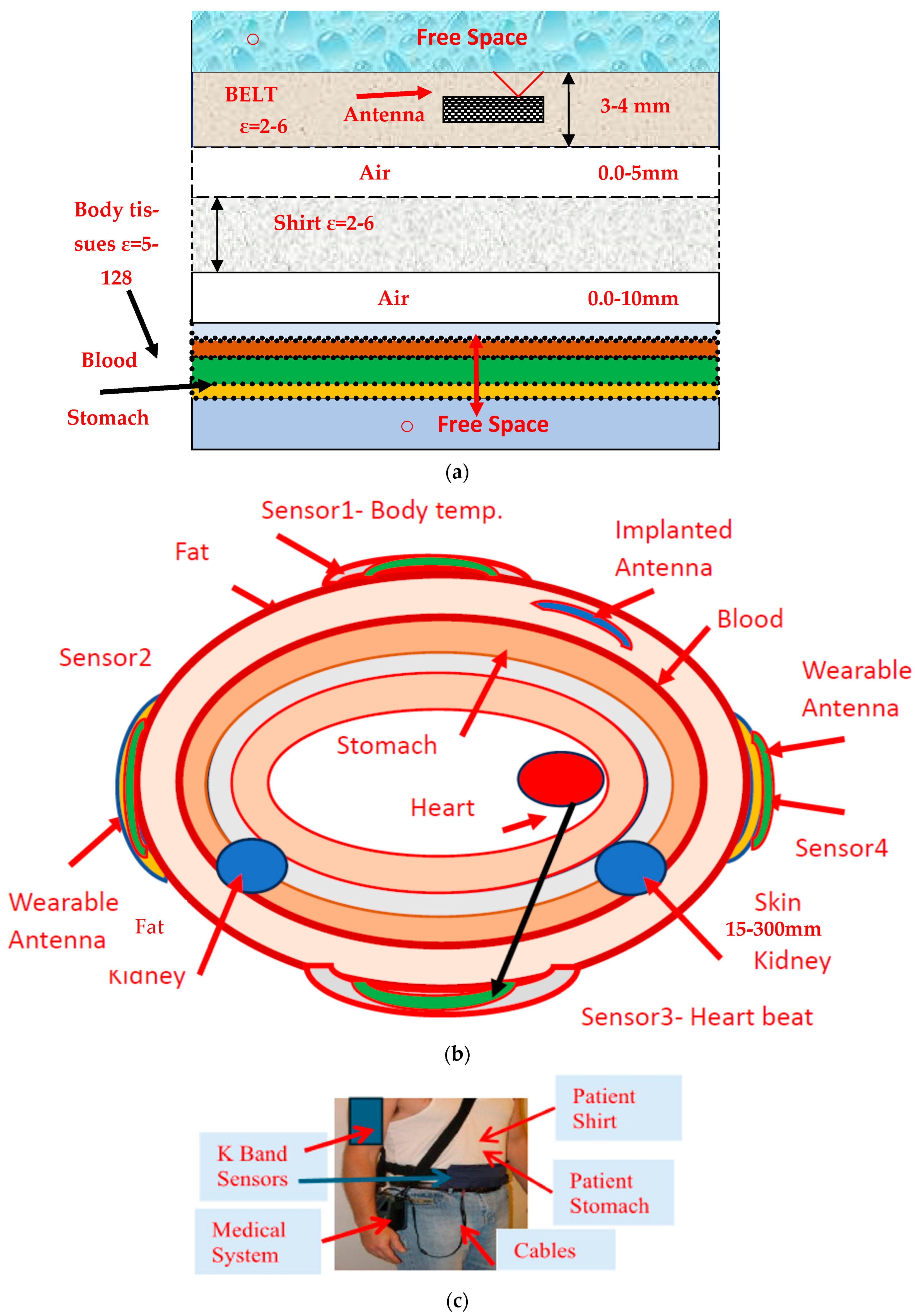

| Antenna Type | Freq. GHz | Gain dB | BW % | Effic. % | Beamwidth | Application Smart Devices | Reference | |
|---|---|---|---|---|---|---|---|---|
| θE° | θH° | |||||||
| Printed dipole | 0.1–12 | 2–3 | 5–8 | 80 | 90 | 90 | Communication | [6,7,8] |
| Patches | 1–40 | 3–4 | 1–2 | 80 | 90 | 90 | Medical, 5G, IoT | [6,7,8] |
| Stacked Fractal | 1–18 | 7.8 | 8–10 | 91 | 76 | 78 | Medical, 5G, IoT | [6,7,8] |
| Meta-Fractal Patch | 1–12 | 8 | 20 | 90 | 76 | 90 | Medical, 5G, IoT, Smart devices | [59] |
| Slot | 16–26 | 2–4 | 26 | 90 | 76 | 90 | Medical, 5G, IoT | Present paper |
| Fractal Slot | 16–26 | 3–5 | 26 | 90 | 76 | 90 | Medical, 5G, IoT | Present paper |
| Slot Fractal Array | 16–26 | 7–8 | 45 | 70 | 70 | 90 | Medical, 5G, IoT | Present paper |
| Slot Array | 16–26 | 7–8 | 45 | 70 | 70 | 90 | Medical, 5G, IoT | Present paper |
| Active Antennas | 1–6 | 13 | 50 | 90 | 74 | 74 | Medical, 5G, IoT | [6,7,8] |
| Tissue | Parameter | 0.6 GHz | 1 GHz | 2 GHz | 5G Hz | 10 GHz | 20 GHz |
|---|---|---|---|---|---|---|---|
| Fat tissues | σ | 0.05 | 0.054 | 0.1 | 0.3 | 0.5 | 1 |
| ε | 5.00 | 4.72 | 4.5 | 4.3 | 4.2 | 4.0 | |
| Muscle tissues | σ | 0.8 | 1 | 1.5 | 5 | 11 | 22 |
| ε | 56 | 55 | 53 | 50 | 40 | 25 | |
| Blood | σ | 1.8 | 1.9 | 2 | 5 | 15 | 28 |
| ε | 59 | 58 | 56 | 51 | 40 | 25 | |
| Skin | σ | 0.6 | 0.7 | 1 | 3 | 9 | 20 |
| ε | 46 | 45 | 43 | 40 | 33 | 23 |
| Sensors | Frequency (GHz) | BW % | BW% Measured | Computed Gain dBi | Measured Gain dBi * | Antenna Area (cm) | Efficiency ** % |
|---|---|---|---|---|---|---|---|
| K band slot Figure 2 | 18–26 | 36 | 36 | 3 | 3–4 | 1.5 × 1.5 | 86–92 |
| K band slot Figure 4 | 18–26 | 32 | 32 | 4 | 4–4.3 | 2 × 2 | 88–92 |
| Fractal slot Figure 10 | 18–26 | 25 | 26 | 4 | 4–4.5 | 2 × 2 | 85–90 |
| K band slot Figure 14 | 18–26 | 28 | 28 | 5.5 | 5.5–5.8 | 2 × 2 | 86–92 |
| Fractal array Figure 18 | 16–26 | 45 | 45 | 7.5 | 7.5–7.8 | 3 × 3 | 85–90 |
| Slot array Figure 23 | 16.4–26 | 44 | 44 | 7.5 | 7.5–7.8 | 3 × 3 | 85–90 |
Disclaimer/Publisher’s Note: The statements, opinions and data contained in all publications are solely those of the individual author(s) and contributor(s) and not of MDPI and/or the editor(s). MDPI and/or the editor(s) disclaim responsibility for any injury to people or property resulting from any ideas, methods, instructions or products referred to in the content. |
© 2025 by the author. Licensee MDPI, Basel, Switzerland. This article is an open access article distributed under the terms and conditions of the Creative Commons Attribution (CC BY) license (https://creativecommons.org/licenses/by/4.0/).
Share and Cite
Sabban, A. Wearable K Band Sensors for Telemonitoring and Telehealth and Telemedicine Systems. Sensors 2025, 25, 5707. https://doi.org/10.3390/s25185707
Sabban A. Wearable K Band Sensors for Telemonitoring and Telehealth and Telemedicine Systems. Sensors. 2025; 25(18):5707. https://doi.org/10.3390/s25185707
Chicago/Turabian StyleSabban, Albert. 2025. "Wearable K Band Sensors for Telemonitoring and Telehealth and Telemedicine Systems" Sensors 25, no. 18: 5707. https://doi.org/10.3390/s25185707
APA StyleSabban, A. (2025). Wearable K Band Sensors for Telemonitoring and Telehealth and Telemedicine Systems. Sensors, 25(18), 5707. https://doi.org/10.3390/s25185707








